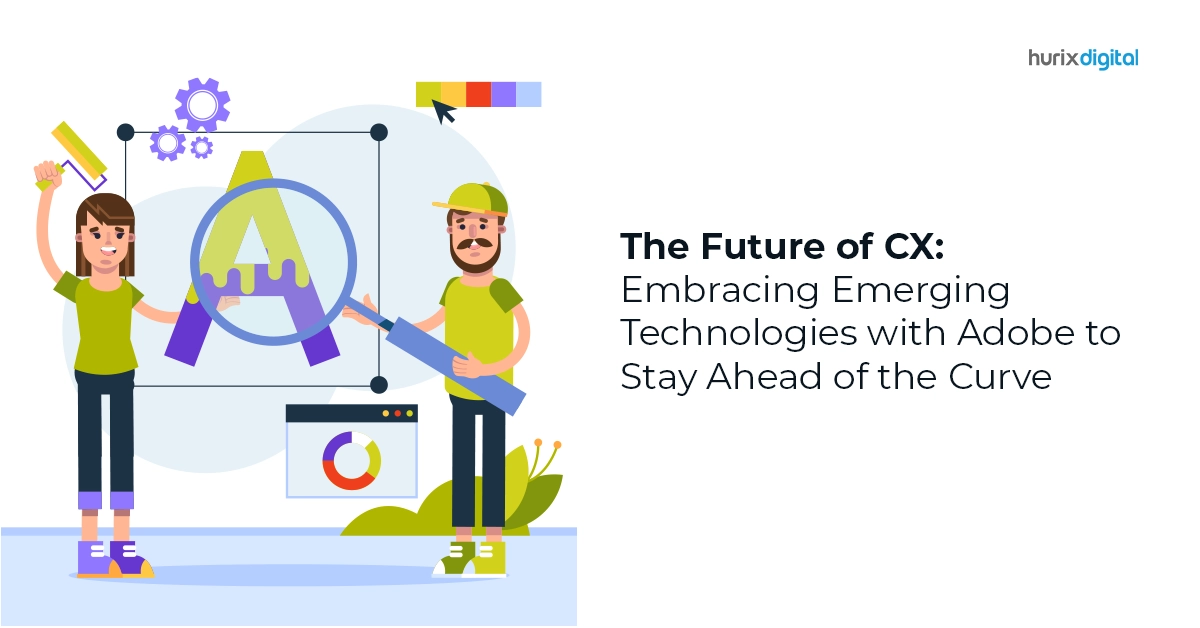
The Future of CX: Embracing Emerging Technologies with Adobe to Stay Ahead of the Curve
Summary
Discover how Adobe’s advanced solutions, utilizing AI, gamification, blockchain, and AR/VR, are transforming customer experiences and providing businesses with a competitive advantage.
The evolution of technology has reshaped various industries, from healthcare to finance and everything in between. The digital customer experience has become a key component of success within the business realm. Technological advancements present endless opportunities to elevate the customer experience, making it a pivotal factor in the success of modern enterprises.
As a growing number of customers prefer engaging with brands through digital channels, businesses are adapting to meet these evolving expectations. Here, Adobe takes center stage with its innovative solutions, including Adobe Customer Experience Management, Adobe Managed Services, and AEM Adobe Experience Manager.
In this article, we’ll take a look into the potential of Adobe’s offerings, exploring how these tools, coupled with emerging technologies like artificial intelligence (AI), blockchain, and AR and VR technology, are shaping the future of CX to keep businesses ahead of the curve.
Table of Contents:
- The Role of Software Development in Shaping Emerging Technologies
- Exploring the Partnership of Adobe with Emerging Technologies in Customer Experience (CX)
- Wrapping Up
The Role of Software Development in Shaping Emerging Technologies
In establishing a robust presence in the dynamic technology market, organizations actively craft cutting-edge software applications and systems, leveraging the full potential of emerging technologies. This proactive approach not only allows companies to gain a competitive edge but also enables them to adapt swiftly to market dynamics and meet the ever-evolving needs of their customer base.
Consumers express a desire for quicker responses to their changing needs, with 64% expressing a wish for companies to respond faster. Interestingly, 88% of executives perceive that their customers are changing faster than their business can keep up.
Embracing a life-centric approach to customer experience enables businesses to actively engage customers at crucial moments, fostering connections that endure amidst continuous change and disruption.
Adobe, with its open architecture and developer-friendly ecosystem, facilitates this seamless integration and customization journey. Organizations can create unique and highly personalized customer journeys by embracing custom software development with Adobe’s CX solutions. This ensures businesses are not only equipped with cutting-edge technology but also have the flexibility to tailor experiences to the unique needs of their customer base.
Also Read: Key Features and Capabilities of Adobe Experience Manager
Exploring the Partnership of Adobe with Emerging Technologies in Customer Experience (CX)
Adobe’s commitment to delivering exceptional CX is evident in its comprehensive suite of tools. Adobe Customer Experience Management (CXM) is a strategic approach that integrates various aspects of marketing, sales, and service to create seamless and personalized customer interactions. This platform is a game-changer for businesses looking to elevate their CX strategies.
At the heart of Adobe’s CX suite lies Adobe Experience Manager. This dynamic content management solution empowers businesses to create, manage, and optimize digital customer experiences across various channels. By leveraging AEM, organizations can deliver consistent and engaging content, fostering stronger connections with their audience.
1. Artificial Intelligence (AI)
By leveraging AI capabilities, Adobe can enhance content creation and personalization, automate the generation of tailored marketing materials, and dynamically adjust strategies based on predictive analytics.
- The integration of AI-driven chatbots into Adobe platforms facilitates real-time, personalized customer interactions, improving engagement and support.
- AI-powered image and video recognition within Adobe Creative Cloud can optimize content organization and accessibility.
- Voice and language processing technologies can be integrated to create voice-enabled interfaces.
- AI-enhanced security measures contribute to robust data protection and compliance.
This collaboration between Adobe and AI not only streamlines marketing efforts but also ensures a more personalized, efficient, and secure CX, positioning businesses at the forefront of technological innovation in the digital landscape.
2. Gamification
The global gamification market was estimated at USD 6.33 billion in 2019 and is expected to grow at a CAGR of 24.8% to reach USD 37.00 billion by 2027, with retail holding a potentially large share in this market.
Gamification is playing a transformative role in shaping the future of CX, providing businesses with innovative ways to engage with their customers.
- When businesses integrate gamification with Adobe’s suite of tools, they can connect with customers in unique and interactive ways, fostering more enjoyable and rewarding experiences.
- From incorporating game-like elements into loyalty programs to developing interactive apps, Adobe’s platform becomes a dynamic space for businesses to connect with their audience.
- Gamification not only differentiates businesses in a competitive landscape but also positions Adobe at the forefront of innovative approaches to customer engagement, satisfaction, and customer loyalty.
3. Blockchain Technology
Blockchain ensures the security and transparency of customer transactions. By incorporating blockchain into Adobe’s platforms, businesses can ensure the security and transparency of customer transactions, particularly in industries like finance and e-commerce.
This decentralized and tamper-proof system not only enhances the trustworthiness of transactions but also contributes to building a more transparent and customer-focused ecosystem. This unity lets businesses offer customers a clear view of product origins, authenticity, and transaction history, fostering trust and confidence.
4. Augmented Reality (AR) and Virtual Reality (VR)
By harnessing Adobe’s robust platform, businesses can create captivating AR and VR experiences that transcend traditional boundaries. Some examples include:
- Immersive virtual try-on sessions in the fashion industry
- Dynamic product visualizations
- Interactive 3D presentationsMoreover, Adobe’s tools empower businesses to craft visually stunning and interactive content, enriching CX through personalized and memorable encounters.
This integration redefines how customers interact with brands.
Also Read: How AI is Revolutionizing Design with Adobe Photoshop in 2024?
Wrapping Up
In the world of digital customer experience, businesses need to adopt a customer-centric approach, focusing on customer needs and preferences. To excel in software development for emerging technologies, developers should adopt agile methodologies for quick responses and effective collaboration.
The future of digital CX holds immense potential with emerging technologies like generative AI, AR/VR, IoT, and blockchain. While technology plays a pivotal role, it’s essential to recognize that digital CX success requires a clear methodology and strategy. Companies must commit to delivering a seamless, integrated customer experience across all touchpoints.
If you want to learn more about how to use emerging technologies to shape the future of CX, Hurix Digital stands as a valuable partner. By reaching out to Hurix Digital, businesses can gain access to expert guidance and innovative solutions tailored to navigate the dynamic landscape of the digital customer experience!

Currently serving as the Vice President of Technology Delivery Operations at HurixDigital, a prominent global provider of digital content and technology solutions for publishers, corporations, and educational institutions. With over 16 years of experience spanning EdTech and various domains, I hold certification as a SCRUM Product Owner (CSPO). My expertise includes operations, finance, and adept people management skills.



